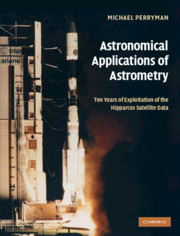Book contents
- Frontmatter
- Contents
- Preface
- 1 The Hipparcos and Tycho Catalogues
- 2 Derived catalogues and applications
- 3 Double and multiple stars
- 4 Photometry and variability
- 5 Luminosity calibration and distance scale
- 6 Open clusters, groups and associations
- 7 Stellar structure and evolution
- 8 Specific stellar types and the ISM
- 9 Structure of the Galaxy
- 10 Solar System and exoplanets
- Appendix A Numerical quantities
- Appendix B Acronyms
- Appendix C Author gallery
- Index of first authors
- Subject index
9 - Structure of the Galaxy
Published online by Cambridge University Press: 23 November 2009
- Frontmatter
- Contents
- Preface
- 1 The Hipparcos and Tycho Catalogues
- 2 Derived catalogues and applications
- 3 Double and multiple stars
- 4 Photometry and variability
- 5 Luminosity calibration and distance scale
- 6 Open clusters, groups and associations
- 7 Stellar structure and evolution
- 8 Specific stellar types and the ISM
- 9 Structure of the Galaxy
- 10 Solar System and exoplanets
- Appendix A Numerical quantities
- Appendix B Acronyms
- Appendix C Author gallery
- Index of first authors
- Subject index
Summary
Introduction
Overall structure of the Galaxy
Billions of stars, as well as planets, interstellar gas (predominantly atomic and molecular hydrogen), interstellar dust, and dark matter are gravitationally bound to form the Galaxy – a magnificent disk spiral system, supported by rotation. Most of the visible stars in the Galaxy, some 1011 objects of all types, masses and ages, lie in a flattened disk, a roughly axisymmetric structure whose constituent stars have formed at a fairly steady rate throughout the history of the Galaxy. They have a relatively high metal content compared to primordial abundances, inherited from the interstellar gas from which they formed, itself comprising the metal-rich debris of exploding supernovae. The Sun is located at about 7.5–8.5 kpc from the Galactic centre, and moves around it in a roughly circular orbit in a period of about 250 million years. The disk appears to be segregated into ‘thin’ and ‘thick’ components with different scale heights, angular rotation, ages, and metallicity. It shows significant spatial and kinematic structure, notably spiral arms, a central bar, and a warping of the outer plane.
The inner kpc of the disk also contains the bulge, which is less flattened, and consists mostly of fairly old stars. At its centre lies a super-massive black hole of ∼3×106M⊙. The stellar bulge is a major element of galaxy classification schemes, and may be relatively small (like the Milky Way), or large and luminous. It includes an old population traced by bulge RR Lyrae stars, but probably includes stars with a wide range of ages.
- Type
- Chapter
- Information
- Astronomical Applications of AstrometryTen Years of Exploitation of the Hipparcos Satellite Data, pp. 490 - 565Publisher: Cambridge University PressPrint publication year: 2008

